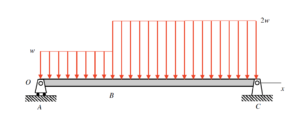Problem statement
Solution video
DISCUSSION THREAD

Please post questions here on the homework, and take time to answer questions posted by others. You can learn both ways.
Problem statement
Solution video
DISCUSSION THREAD

You must be logged in to post a comment.
Just want to note that the problem statement says the cross section area is 2 ft by 4 ft which I believe is supposed to be inches. If an instructor or TA is reading this, should we change the ft to inches or just solve it in the wacky way it is?
Try solving it out as is. It works out to be pretty realistic numbers. All you have to do is convert the moment from kip-ft to kip-inches by multiplying by 12, and then do the rest of your equations as is (converting the y-max and area moment to inches before calculating!).
does our maximum normal stress need to be in psi ?
I haven't worked out the problem yet, but I think ksi or psi either works, as long as the units cancel.
I kept mine in kips/ft^2 (equal to ksi) because it never specified the specific units to use. I'm guessing any unit is fine as long as you make sure its converted correctly.
Unfortunately ksi is 1kip/square inch, not 1kip/square foot. 144 kips/ft^2 is equal to 1ksi (kip/square inch). To avoid future confusion, ksi can be remembered as an acronym for Kips / Square Inch
I believe converting everything into inches is easiest.
To determine where pure bending exists, is drawing a basic shear and moment graph the best way to go about it? Or are there simpler methods you would recommend?
That is what they want you to do. It is a pretty good method for finding pure bending.
The professor recommended to start by drawing the diagrams because they can very see where pure bending happens.
I did mine by drawing out the shear graph and see where the shear is 0 to see where bending occurs.
drawing it is not only is it easier to see where the pure bending happens but also allows you to have a visual of the forces on the bar.
In my opinion its the best way as you have a visual which helps quite a bit in finding pure bending.
Is I=(b^2)(h^2)/4 the correct value?
Yes, I believe so
The resources I found online said I is b^3 * h / 12. I'm not sure which one is correct, though.
It looks like the mentioned b^2 * h^2 / 4 matches the units.
How exactly can we check ourselves to know we have the correct answer?
I would say just verify the equilibrium is correct and ensure correct signs.
The graphs were really helpful for checking my M and V values, as well as the location of pure bending. As for the max stress, you just have to use the right equations and make sure your units cancel.
You can always check yourself by going to office hours. A little late for this homework, but for homework 36 and 37 you can do this.
I had I equal to b(h^3)/12, which is slightly different than what others are saying.
I also got 1/12 bh^3
Never mind its b^3
1/12 bh^3 is what Professor Jones used in an example video (Ex. 3 soln), so I'm assuming that's the correct calculation for I.
Do we use that same equation for any beam in this course?
Yes, this is the correct formula for I in this case.
Do you start by finding the equivalent forces and determining the reactant forces? and is the shear force convention with V on the left pointing in -j and V on the right in +j?
For the second moment of inertia of rectangular cross-section, I found two equations to calculate that: I_y = wh^3/12 and I_x = hw^3/12, where w represents the width and h represents height. I am wondering whether I should use the first one, as it corresponds to the direction of the distance from the neutral axis (which is y according to sigma = M*y/I).
In this problem, I drew the shear and moment diagrams first to clearly see where the pure bending moments exist. To help my classmates I noticed that most of the units canceled out and left a clear answer at the end.
Thinking practically, would it be wrong to think of this type of loading as sort of like a triangle in the actual beam, where it starts off small but increases with the added double-distributed load?